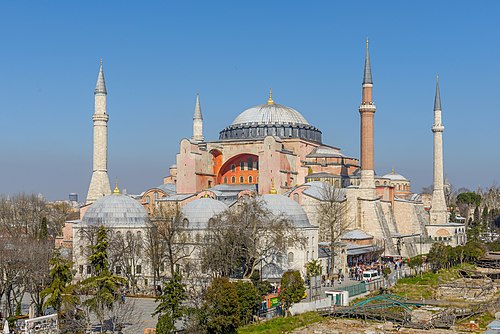Facts for Kids
Hagia Sophia is an iconic architectural marvel that has served as a cathedral, mosque, and museum, symbolizing the convergence of diverse cultural and religious traditions throughout history.
Overview
Art And Mosaics
Cultural Impact
Preservation Efforts
Religious Transitions
Architectural Features
Historical Significance
Controversies And Debates
Tourism And Accessibility

Inside this Article
The Blue Mosque
Calligraphy
Combination
Government
Building
Istanbul
Culture
People
Beauty
Did you know?
🏛️ Hagia Sophia was originally constructed as a cathedral in 537 AD and was the world's largest cathedral for nearly 1,000 years.
🕌 It served as the central church of Eastern Orthodox Christianity before being converted into a mosque in 1453.
🌍 The structure has immense cultural significance, symbolizing the intersection of Christian and Islamic heritage.
🎨 Its stunning mosaics and architecture are considered masterpieces of Byzantine art.
📚 Hagia Sophia has been designated as a UNESCO World Heritage Site, emphasizing its global cultural importance.
🔔 The building's massive dome was an engineering marvel of its time and inspired many subsequent structures.
📈 It attracts millions of visitors each year, reflecting its historical and artistic significance.
🤲 Hagia Sophia has served as a place of worship for various faiths throughout its history, showcasing religious diversity.
🕰️ The site represents the transition from ancient to modern times, embodying centuries of history.
🖼️ Its architectural influence can be seen in many mosques, churches, and buildings across the world.
Introduction
️✨ The Hagia Sophia is known for its massive dome and beautiful mosaics that make it a wonderful place to learn about history! It is also one of the largest and oldest churches in the world, standing proud for over 1,400 years! This special building shows how different cultures can come together. 🎉
Art And Mosaics
Cultural Impact
️✨ Many buildings, like the Blue Mosque in Istanbul, were designed by looking at Hagia Sophia. It has a unique blend of Christian and Islamic art, showing how these cultures can celebrate their beliefs together. 📖🌙 People visit it not only to admire its beauty but also to learn about the different cultures it represents. It also plays an essential role in Turkish culture, as it is a symbol of Istanbul's rich and diverse history!
Preservation Efforts
️✨ Many experts and conservationists work hard to keep this beautiful building safe from wear and tear. In the 20th century, the Turkish government repaired the structure to preserve its historic value. They check its walls and the magnificent mosaics to ensure everything is in good shape. People around the world want to keep Hagia Sophia intact for future generations, proving that history matters and should be respected. 🌍💕
Religious Transitions
It became a museum in 1935, promoting unity and understanding among different faiths. Today, it is open to everyone, regardless of belief! The building stands as a place where people can learn about the layers of history and how different religions can exist together.
Architectural Features
️✨ The dome measures 102 feet in diameter and seems to float above the building. It is supported by massive arches, giving it a unique look. The walls are also covered in beautiful mosaics displaying scenes from the Bible and amazing Islamic designs. 🌈
The clever engineers who built it used bricks and stones, and you can see the incredible craftsmanship in every corner. The combination of round and square shapes makes it very special and different from other buildings!
Historical Significance
Controversies And Debates
This historical building continues to be a source of pride for many, bridging cultures, opinions, and faiths around the world!
Tourism And Accessibility
🦽 Everyone is welcome to see this wonder!

